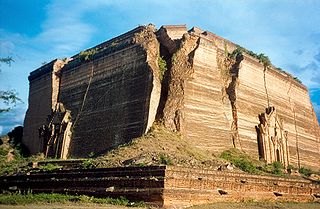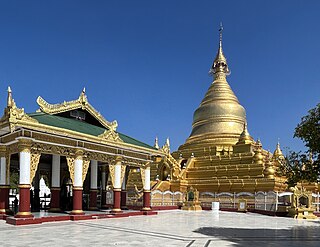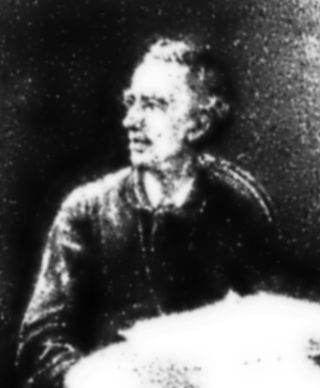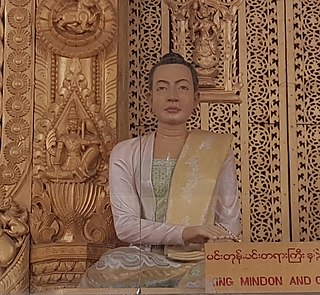
Mandalay is the second-largest city in Myanmar, after Yangon. Located on the east bank of the Irrawaddy River, 631 km north of Yangon, the city has a population of 1,225,553.

Mingun is a town in Sagaing Township of Sagaing Region, north-west Myanmar (Burma), located 11 km up the Ayeyarwady River on the west bank from Mandalay. Its main attraction is the ruined Mingun Pahtodawgyi.

Amarapura is a former capital of Myanmar, and now a township of Mandalay city. Amarapura is bounded by the Irrawaddy river in the west, Chanmyathazi Township in the north, and the ancient capital site of Ava (Inwa) in the south. It was the capital of Myanmar twice during the Konbaung period before finally being supplanted by Mandalay 11 kilometres (6.8 mi) north in 1859. It is historically referred to as Taungmyo in relation to Mandalay. Amarapura today is part of Mandalay, as a result of urban sprawl. The township is known today for its traditional silk and cotton weaving, and bronze casting. It is a popular tourist day-trip destination from Mandalay.

Inwa, located in Mandalay Region, Myanmar, is an ancient imperial capital of successive Burmese kingdoms from the 14th to 19th centuries. Throughout history, it was sacked and rebuilt numerous times. The capital city was finally abandoned after it was destroyed by a series of major earthquakes in March 1839. Though only a few traces of its former grandeur remain today, the former capital is a popular day-trip tourist destination from Mandalay.

The Mandalay Palace, located in Mandalay, Myanmar, is the last royal palace of the last Burmese monarchy. The palace was constructed between 1857 and 1859 as part of King Mindon's founding of the new royal capital city of Mandalay. The plan of Mandalay Palace largely follows the traditional Burmese palace design; it is inside a walled fort surrounded by a moat. The palace itself is at the centre of the citadel and faces east. All buildings of the palace are of one storey in height. The number of spires above a building indicated the importance of the area below.

The Mahamuni Buddha Temple is a Buddhist temple and major pilgrimage site, located southwest of Mandalay, Myanmar (Burma). The Mahamuni Image is enshrined in this temple, and originally came from Arakan. It is highly venerated in Burma and central to many people's lives, as it is seen as an expression of representing the Buddha's life.

Shwenandaw Monastery is a historic Buddhist monastery located near Mandalay Hill, Mandalay Region, Myanmar.

Kuthodaw Pagoda is a Buddhist stupa, located in Mandalay, Burma (Myanmar), that contains the world's largest book. It lies at the foot of Mandalay Hill and was built during the reign of King Mindon. The stupa itself, which is gilded above its terraces, is 188 feet (57 m) high, and is modelled after the Shwezigon Pagoda at Nyaung-U near Bagan. In the grounds of the pagoda are 729 kyauksa gu or stone-inscription caves, each containing a marble slab inscribed on both sides with a page of text from the Tipitaka, the entire Pali Canon of Theravada Buddhism.

Islam is a minority religion in Myanmar, practised by about 2.1% of the population, according to the 2014 Myanmar official statistics.

Stone tablets inscribed with the Tripiṭaka stand upright in the grounds of the Kuthodaw Pagoda at the foot of Mandalay Hill in Mandalay, Myanmar (Burma). The work was commissioned by King Mindon as part of his transformation of Mandalay into a royal capital. It was completed in 1868. The text contains the Buddhist canon in the Burmese language.

Mandalay District was a district of the Mandalay Region in central Myanmar. Though the district used to consist of two cities, Mandalay and Amarapura, today, with the urban sprawl of Mandalay capturing Amarapura and Patheingyi, the district and the city of Mandalay are one and the same. The district was dissolved and formed as Aungmyethazan District, Maha Aungmye District and Amarapura District on 30 April 2022.
U Nu Mohamad Kassim, better known as Saya Gyi U Nu, or U Nu, was a leading Burmese Muslim writer during the reign of King Bodawpaya. He combined words and terms from Burmese religious literature with poetic writing and Islamic ideas to produce books which are regarded as classics of Burmese Muslim literature. Bodawpaya appointed him to head a mission to India, to retrieve books and scriptures in Sanskrit, Hindi, Urdu, and Persian. Nu was appointed the Mayor of Yammar Wati with the title Shwe Taung Thargathu, which means "Hero of the Ocean".

The Bagaya Monastery, located in Inwa, Mandalay Region, Burma (Myanmar) is a Buddhist monastery built on the southwest of Inwa Palace. This magnificent monastery is also known as Maha Waiyan Bontha Bagaya Monastery. During King Hsinbyushin's reign (1763–1776), Maha Thiri Zeya Thinkhaya, town officer of Magwe built the monastery in the Bagaya monastic establishment and dedicated to Shin Dhammabhinanda. It is one of the famous tourists attractions in Burma.

Taiktaw Monastery is a royal Buddhist monastery in Mandalay, Burma, known for its bold wooden carvings. The central building was the residence of the Thathanabaing, and the posts were taken from the Amarapura Palace. It was built by King Mindon Min in 1859, and was used under the Burmese monarchy as the official residence of the Thathanabaing.

The Konbaung tombs are a collection of mausoleums built by Konbaung dynasty kings. They are scattered throughout the former royal capitals of Mandalay Region, including Mandalay, Amarapura, and Inwa.
The architecture of Myanmar, in Southeast Asia, includes architectural styles which reflect the influence of neighboring and Western nations and modernization. The country's most prominent buildings include Buddhist pagodas, stupas and temples, British colonial buildings, and modern renovations and structures. Myanmar's traditional architecture is primarily used for worship, pilgrimage, storage of Buddhist relics, political activism and tourism.

Colesworthey Grant was an English artist, writer and pioneer activist against cruelty to animals in India. Teaching himself art and sketching, he produced numerous portraits of many early East India Company servants of influence in Calcutta which were published in the local periodicals of the time. He later became a professor of drawing. He founded the "Calcutta Society for the Prevention of Cruelty to Animals" in 1861 after seeing the sorry conditions especially of draught animals on the streets of Calcutta.

Thiri Pawara Atula Tilawka Maha Yazeinda Adhipati Yadana Dewi, commonly known as Setkya Dewi or Sekkya Dewi, was Queen of the Konbaung Kingdom of Burma from 26 March 1853 to 12 November 1876 as the chief queen of Mindon Min. Born to Tharrawaddy Min and his wife, she held the position of the Tabindaing Princess during her father's reign. Being renowned for her knowledge of modern science and astrology, Setkya Dewi was popular with the British, who described her as a well-educated woman, and visitors would often bring her gifts related to her astrological interests.

Nagayon Pagoda is a Buddhist temple in Amarapura, a former royal capital in Mandalay Region, Myanmar (Burma). The temple was built by Anauk Nanmadaw Ma Mya Lay, the Queen of the Western Palace during the reign of Bagyidaw, during the first half of the 1800s. The temple's exterior is known for its unusual design. The roof of the temple is draped by the naga Mucalinda, who protected the Buddha from the elements while achieving enlightenment.

Thu Thiri Myatswa Ratana Devi, commonly known as the Princess of Salin or Salin Supaya, was the Tabindaing princess during the late Konbaung dynasty. She was nicknamed "Selina Sophia" by Europeans. As a favourite daughter of King Mindon and one who was proficient in mathematics, she served as head of the royal treasury during the reign of King Mindon.
























